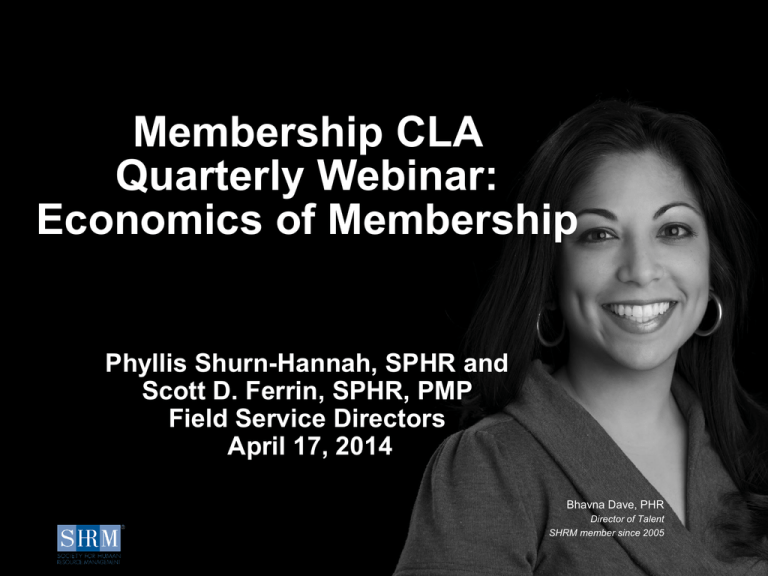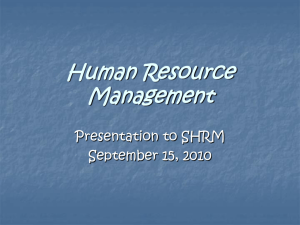
1
Membership CLA
Quarterly Webinar:
Economics of Membership
Phyllis Shurn-Hannah, SPHR and
Scott D. Ferrin, SPHR, PMP
Field Service Directors
April 17, 2014
Bhavna Dave, PHR
Director of Talent
SHRM member since 2005
©SHRM 2014
Agenda
2
• Welcome
• Affiliation Requirement and Monthly
Membership Report
• At-Large Postcards
• Membership Value and VLRC
• Guests and Presentation
• Q&A
• Future Meetings
©SHRM 2014
SHRM Membership
3
SHRM Chapter Membership Requirements as of January 1, 2012
100%-Chapters
Non-100%-Chapters
• Minimum of 25 SHRM members
AND
• 100% SHRM membership
• Minimum of 25 SHRM members
AND
• 51% SHRM membership
Applies to all existing and new chapters - no grandfathering. Chapters
not currently meeting new affiliation requirements will have a five-year
period to do so (by December 31, 2016).
Three more years to
meet the requirements
©SHRM 2014
Membership Report – State Rollup
4
2014 Star & Super Star Goals:
•
•
Membership Star = 1% - 3.99%
Membership Super Star = 4%+
(over the 12/31/13 count)
©SHRM 2014
Membership Report – Chapter Review
5
2014 Star & Super Star Goals:
•
•
Membership Star = 1% - 3.99%
Membership Super Star = 4%+
(over the 12/31/13 count)
©SHRM 2014
SHRM At-Large Strategy
6
Promoting Chapter Membership to SHRM At-Large Members
Recently, SHRM sent out 2 communications
to domestic SHRM at-large members.
The first was a postcard sent to 70,000
members with under 2 years of membership
with SHRM with a message promoting local
chapters. It was also customized based on
their zip code with a listing of the closest
chapters to them.
Also, SHRM sent out an e-blast to more than
125,000 SHRM at-large members with a
message about the benefits of joining their
local chapter. It included a link to find the
chapters in their state.
We believe that these efforts will result in
some new members to our chapters
throughout the U.S.
©SHRM 2014
SHRM Membership
7
ROI of SHRM Membership
We’ve run the numbers for you:
12 Issues of HR Magazine
$
Reading 3 of the more than 50 research reports
$ 299.85
Participation in 12 webcasts from other
organizations
$1,500.00
Savings by not having to pay some consultant fees
Full access to SHRM sample forms, policies,
how-to guides and presentations
70.00
Your
estimate
$ 300.00
SHRM Membership Value = $2,169.85 or higher
You Pay Only $185 for
1 year full professional membership
New, First-Time SHRM Member?
©SHRM 2014 = $170!
Use promo code 0118 to receive a $15 discount off your 1 year full professional membership
SHRM Membership
“Convince Your Boss” Presentation
8
www.shrm.org/about/membership
©SHRM 2014
May 2014 SHRM Membership Promo
The Online Promotion offers
FIRST-TIME new members special
membership rates when they join
May 1 – May 31 using the ONLINE
membership application only, excluding
the bill me option and pdf forms that are
printed off and mailed/faxed in with
payment.
9
Save $15 and get
a SHRM Tote Bag
•U.S. and U.S. territory residents = $170
•Special targeted promotion to U.S. and
U.S. territory residents = $170 (with
promo code)
•Outside the U.S. or its territories = $80
internet-only membership or $170 full
professional membership
©SHRM 2014
10
The Main Event
©SHRM 2014
The Economics of
Membership
© 2014 Marketing General Incorporated. All rights reserved
12
Key Membership Calculations
•Response Rate
•Cost to Obtain a Member
•Renewal Rate
•Average Tenure
•Lifetime Value
•Maximum Acquisition Cost
•Steady State Analysis
13
Response Rate
Measures the number of prospects who
responded to a marketing effort.
Response Rate = Total number of
responses / Total number of prospects
contacted X 100.
14
Response Rate - Example
ABC Association Direct Mail Acquisition Campaign:
Package A:
• 1,000 prospects mailed
• Through promo code tracking, we see 9 new members join
• The response rate from this mailing is: 9/1,000 *100 = .90%
Package B (testing a different message):
• 1,000 prospects mailed
• Through promo code tracking, we see 12 new members join
• The response rate from this mailing is: 12/1,000 *100 = 1.20%
Response rates help us create a learning system!
15
Cost to Obtain a Member
The cost to obtain a member = costs of acquisition / # of total members
acquired.
Let’s tie this into the previous example. Both packages used the same
components with only the messages varying, so the production costs were
the same. Let’s assume each piece cost $0.60 to produce and mail.
What is your cost to obtain a member for package A and B?
What’s the financial difference between
A
and
B
?
16
Cost to Obtain a Member
A
B
Package A cost = $.60 X 1,000 = $600
Package A new members = 9
Package A Cost to Obtain a Member = $66.67
Package B cost = $.60 X 1,000 = $600
Package B new members = 12
Package B Cost to Obtain a Member = $50.00
17
Renewal Rate
Renewal Rate = (# of members today –
new members over the past 12 months) /
# of members 1 year ago today.
Ex. We have 1,000 members today. 280
new members came in over the past 12
months. One year ago today we had 900
members. What is our renewal rate:
(1,000-280)/900 = 720/900 = 80%
TIME TO RENEW
18
Average Tenure
Avg. Tenure defines how long on average members
stay with an association. We need to know our
renewal rate to find this.
Average Tenure = 1/(Inverse of renewal rate)
Inverse of Renewal Rate = 1 – renewal rate (also
known as lapse rate)
If we have a renewal rate of 80% how long on
average do members stay with our organization?
Average Tenure = 1 / (1 - .80) = 1 / .2 = 5 years
19
Getting to Lifetime Value (LTV)
Revenue Gained across Average
Tenure
20
Lifetime Value (LTV)
Using our average tenure, we can understand the economic
value of a member over time.
1. Lifetime Value = (Average annual dues revenue + average
annual non-dues revenue per member) * Average Tenure
2. With annual dues of $50 and average annual non-dues of
$25 what is the lifetime value of our members?
3. Lifetime Value = ($50+ $25) * 5 = ($75 * 5) = $375
Knowing that on average we will receive $375 per member we
bring in, we can spend more than the $50 1st-year dues
amount to invest in more members and greater long term
revenues. Getting new members is an INVESTMENT.
21
Maximum Acquisition Cost (MAC)
Defines the theoretical maximum investment that can be made
to acquire a member or customer at a profit.
MAC = ((Avg. dues rev. + avg. non-due rev.) – (Incremental annual
servicing costs + avg. cost of goods sold)) * Avg. Tenure
At what point are we going over the amount we should spend
on acquiring new members?
22
A Note on Incremental Servicing Costs
Costs that exist whether you get a
new member or not
Incremental Servicing Costs
• Mailing a welcome kit
• Mailing the magazine/journal
• Sending out renewal notices
•
•
•
•
•
Legal services
Website
Building maintenance and rent
Staff
AMS/Databases
23
MAC Example
Example: Association ABC
Avg. annual dues = $50
Avg. member annual non-dues rev. = $25
Incremental servicing costs = $15
Avg. cost of goods sold = $13
Avg. Tenure = 5 years (80% renewal rate)
What is our MAC:
MAC = (($50 + $25) – ($15 + $13)) * 5
MAC = (($75) – ($28)) * 5
MAC = $47 * 5 = $235
24
Steady State Analysis
• Defines the equilibrium of total membership where
members gained will offset members lost.
• This projects total members over time assuming new
member input and renewal rates remain constant.
Steady State = Annual New Member Input / Lapse Rate
25
Steady State Analysis
THINK OF YOUR MEMBERSHIP AS A LEAKY BUCKET
The water you put into
the bucket each year is
new members
How full the bucket is
represents your total
membership level.
But your bucket leaks.
Each year a certain
percentage of members
do not renew
26
Mapping it Out
Looking at it a little differently…
You start a brand new association.
Your membership starts at zero.
In the first year you acquire 1,000 new members.
Of those members, over the next year 80% renew.
If you were able to continue doing this every year,
acquiring 1,000 new members and renewing 80% of your
members, how large would your association be over
time?
Steady State = 1,000/.2 = 5,000 members
27
Steady State – As Raw Numbers
28
Steady State – Graphed
Total Year-End Members
6,000
5,000
4,981
4,000
3,000
Total Year-End
Members
2,000
1,000
Year 25
Year 23
Year 21
Year 19
Year 17
Year 15
Year 13
Year 11
Year 9
Year 7
Year 5
Year 3
Year 1
0
29
Now We’re Talking “What If?”
What if we invested more in acquisition getting to 1,500 new members a year and
were able to maintain 80% renewals? Then where are we headed?
Steady state = 1,500/.2 = 7,500
What if we invested more in our retention efforts getting 1,000 new members a
year and we get to 85% renewals? Then where are we headed?
Steady state = 1,000/.15 = 6,667
The steady state tool lets you look at different possible scenarios for the number
of members you want to get.
30
Recap of Calculations
1.Response Rate = Total number of responses / Total number of
prospects contacted X 100.
Shows which approaches work best – lists, creative, channels and offers.
2. Cost to obtain a member = costs of acquisition / # of total members
acquired.
Shows how much you are spending to bring someone in.
3. Renewal Rate = (# of members today – new members over the past 12
months) / # of members 1 year ago today.
Tells you how many members you’ve kept overall in a 1-year span.
4.Average Tenure = 1/(Inverse of renewal rate, which is your lapse rate)
Shows the average number of years someone is a member.
31
Recap of Calculations (con’t)
5. Lifetime Value = (Average annual dues revenue + average annual
non-dues revenue per member) * Average Tenure
How much $ a member provides over their lifetime.
6. Maximum Acquisition Cost = ((Avg. dues rev. per member + avg.
non-due rev. per member) – (Incremental Servicing Costs + avg. cost of
goods sold)) * Avg. Tenure
Maximum level to spend on a new member before losing money over
the lifetime.
7. Steady State Analysis = Annual New Member Input / Lapse Rate
The total number of members you are heading toward.
32
Questions?
Jason Gudenius
Account Director
Marketing General Incorporated
jgudenius@marketinggeneral.com
703.706.0392
(Please note that these slides are copyrighted material and may only be distributed to an audience at a SHRM speaker
presentation. Further distribution is not allowed, except with permission by SHRM.)
©SHRM 2014
Future Meetings
34
2014 Membership Meetings
1/23 - Webinar @ 3:00 PM ET
4/17 - Webinar @ 3:00 PM ET
9/4 - Webinar @ 3:00 PM ET
11/20 to 22 - Membership Summit at the
Volunteer Leaders Summit – Washington, DC.
12/2 - Webinar @ 3:00 PM ET
Past webinar information can be found at:
http://www.shrm.org/Communities/VolunteerResources/WebcastArchiv
esforVolunteerLeaders/Pages/default.aspx#archives6
©SHRM 2014
Contact US
35
Jason Gudenius, CDM
Account Director
Phyllis Shurn-Hannah, SPHR
Field Services Director
Jgudenius@marketinggeneral.com
703-706-0392
Web: www.MarketingGeneral.com
phannah@shrm.org
1-800-283-7476, Option 1, Ext. 6293
Scott D. Ferrin, SPHR
Field Services Director
Scott.ferrin@shrm.org
1-800-283-7476, Option 1, Ext. 6453
©SHRM 2014




